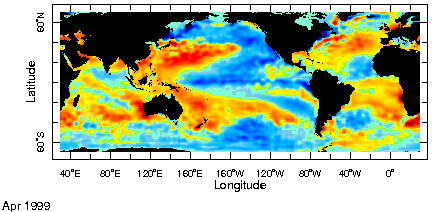
| ||||
IRI Climate Information Digest - April 1999Issued 14 May 1999, Next Issue 14 June 1999
Highlights La Niña conditions persist across the equatorial Pacific. The magnitude and extent of the coldest waters has been continuing to decrease but at a slower rate than in recent months. Most numerical models and empirical forecasts continue the slow decrease in the magnitude of this cold episode for the next several months. It is uncertain whether significant La Niña conditions will persist into the Northern Hemisphere autumn. Sea surface temperatures in the other ocean basins have also been evolving. In the South Atlantic, relatively warm water has replaced colder water evident earlier in the year. Above average sea surface temperatures now dominate the south tropical Atlantic. In the Indian Ocean strong positive temperature departures are evident along the western Australian coast with cooler than average conditions south of India. Global Precipitation Typical La Niña conditions continued to characterize the rainfall patterns in the equatorial Pacific. During April, heavy rains were experienced at many locations west of 150E while drier conditions characterized the area to the east. The border between above and below average rainfall was very closely related to the transition between relatively warm waters in the western Pacific and relatively cold waters in the central and eastern Pacific. Severe rainfall deficits earlier in the evolution of this La Niña have resulted in continued water shortages in parts central of Chile. Rainfall totals were also very low in northeastern Brazil. This despite some tendency for wetter conditions in association with La Niña episodes. The observed wetter than average conditions over parts of southeastern Africa are more typical of cold episodes. Global Temperatures The global temperatures have been above the 1960 to 1990 base period mean every month since April 1997. However, the influence of the La Niña has resulted in lower monthly mean temperatures i.e., smaller positive departures, for each month of 1999 compared to 1998. The average Southern Hemisphere temperatures were actually below the 30-year mean. Colder than average conditions were especially noticeable in Argentina and Australia.
|

